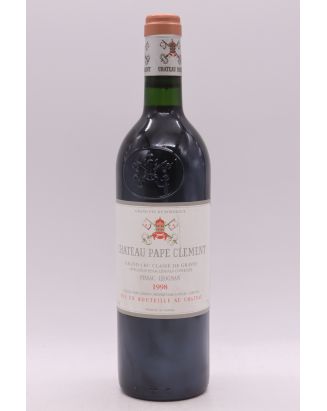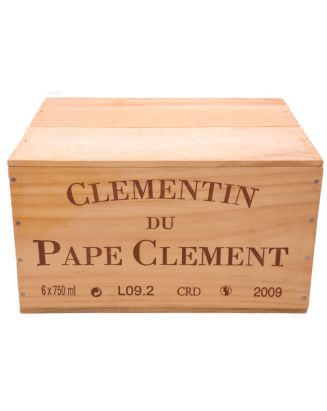










Château Pape Clément takes its name from its most famous owner, Bertrand de Goth, who became Pope Clement V in 1305. This estate has a long and fascinating history that begins in 1252, with the first recorded harvest on these lands then known as Domaine de la Mothe. Bertrand de Goth acquired the property in 1299, when he was Archbishop of Bordeaux. After his election as pope, he developed the art of viticulture, both in Bordeaux and in the Rhône Valley.
In 1309, Clement V ceded the estate to the Archbishopric of Bordeaux, and the vineyard remained under its administration for nearly five centuries. It was not until the French Revolution that the property was auctioned. The modern history of the estate begins in 1939 with its purchase by Paul Montagne, who, despite the ravages caused by a hailstorm in 1937, undertook to resurrect the vineyard. This work was rewarded in 1959 with the classification of Château Pape Clément as a Grand Cru Classé de Graves.
In the 1980s, Bernard Magrez, a visionary entrepreneur, took over the reins of the estate. He introduced modern techniques and rigorous plot-by-plot monitoring, allowing Pape Clément to regain its worldwide renown. Under his direction, the estate has received prestigious distinctions, such as the 100/100 scores awarded by the famous critic Robert Parker for the white wine (2009) and red wine (2010) vintages.
The 2010 red and 2009 white vintages of Château Pape Clément have been awarded the perfect score of 100/100 by Robert Parker. The 2005 and 2009 reds scored 99/100, while the 2006 white was rated 98/100, confirming the excellence of this estate's reds and whites.
The Château Pape Clément vineyard extends over 60 hectares within the Pessac-Léognan appellation, in the Graves wine-growing area. This exceptional terroir rests on the oldest of the alluvial terraces, called the "nappe des graves pyrénéennes", covered with a thin layer of Garonne gravel deposited about 1.5 million years ago. This diverse soil allows for optimal expression of the grape varieties cultivated on the property.
The 53 hectares devoted to red grape varieties are composed of 50% Cabernet Sauvignon, 47% Merlot, 2% Petit Verdot and 1% Cabernet Franc. This vineyard is carefully worked to express all the potential of the terroir, with a planting density of up to 9,000 vines per hectare. The vines, with an average age of 30 years, benefit from meticulous care, including manual destemming, Guyot-Poussard pruning, and even the use of animals for traction.
The 7 hectares of white vines are planted with Sémillon (48.5%), Sauvignon Blanc (44.5%), Sauvignon Gris (5.5%) and Muscadelle (1.5%). These grape varieties thrive thanks to the diversity of soils and the slightly cooler climate, offering white wines of great finesse and remarkable elegance.
Vinification at Château Pape Clément relies on a unique combination of ancestral practices and modern technologies, all aimed at achieving excellence. The process begins with manual harvesting in small crates, with a first sorting in the vineyard. Particular care is taken with manual destemming, where about 5% of the best bunches are carefully detached from their stems without damaging the berries. These grapes are then sorted by hand before being sent to the vat room.
For red wines, fermentation takes place in temperature-controlled wooden vats. Each plot being vinified separately, this allows for preserving the specificity of the terroir. Malolactic fermentation takes place in French oak barrels, 65% of which are new, and ageing lasts between 18 and 20 months.
For white wines, the grapes are also fermented as whole bunches in 100% new French oak barrels, without malolactic fermentation. The ageing on lees, which lasts 12 months, allows for developing all the aromatic complexity of the white wine, while retaining remarkable freshness and minerality.
Innovation is also at the heart of the estate's practices. Since 2014, a drone has been used to monitor the plots with unparalleled precision, and other technologies such as Green-Seeker and tractor auto-guidance are integrated to improve vineyard management.
Château Pape Clément produces wines of great renown, both red and white.
Château Pape Clément Rouge - Grand Cru Classé de Graves
The Grand Cru Classé de Graves, Château Pape Clément Rouge, is a powerful and refined wine, marked by great aromatic complexity. Made from Cabernet Sauvignon, Merlot, Petit Verdot and Cabernet Franc, this wine is distinguished by its aromas of black fruits, leather and smoked wood. Its tannic structure is dense but elegant, and its ageing potential is exceptional. It is aged for 18 months in oak barrels, 70% of which are new.
Le Clémentin du Pape Clément Rouge
The estate's second wine, Le Clémentin du Pape Clément, is crafted with the same care as the Grand Vin, but is designed to be enjoyed younger. Aged for 12 months with a proportion of 30% new barrels, it offers fruity aromas and a more accessible texture, while retaining the finesse and richness of the terroir.
Château Pape Clément Blanc
This rare and exclusive white wine, produced in small quantities (less than 10,000 bottles per year), is a true jewel of the Pessac-Léognan appellation. Vinified in Burgundy barrels, it is distinguished by its exotic aromas tinged with musk, its round and fat texture, and its elegant finish. The balance between freshness and minerality makes this white one of the best white wines in Bordeaux.
Le Clémentin du Pape Clément Blanc
As with the red, Le Clémentin Blanc is a second wine intended for earlier consumption. Its precise vinification and partial ageing in ovoid concrete vats give it a delicate texture and great aromatic finesse.
The vintages of Graves and Pessac-Léognan, two Bordeaux appellations, stand out for their consistent quality. The years 1975, 1982, 1983, 1985, 1986, 1988, 1989 and 1990 are particularly prized for their finesse and balance. The vintages 1998, 2000, 2005, 2008, 2009 and 2010 are equally remarkable for their structure and ageing potential. More recently, the vintages 2012, 2014, 2015, 2016, 2017, 2018, 2019 and 2020 confirm this continuing excellence, with wines offering both elegance and longevity.
Explore all the Grands Crus Classés de Graves, an appellation renowned for the diversity and quality of its wines. At the top of the list, the First Growth of 1855, Château Haut-Brion of Pessac-Léognan, is a historical reference. For red andwhite wines, estates such as Château Bouscaut, Château Carbonnieux, Château Malartic-Lagravière, Château Olivier, Château Latour-Martillac and Domaine de Chevalier offer interesting cuvées. For reds, you can discover the wines of Château Fieuzal, Château Haut-Bailly, Château Latour Haut-Brion, Château La Mission Haut-Brion, Château Pape-Clément and Château Smith-Haut-Lafitte. White wine enthusiasts can turn to the productions of Château Couhins, Château Couhins Lurton and Château Laville Haut-Brion. These estates offer you a wide range of wines to discover in the heart of the Graves region.
Château Pape Clément embodies viticultural excellence through the centuries, combining tradition and modernity to produce wines of exceptional quality. Whether through its powerful and complex reds or its elegant and refined whites, this historic estate continues to seduce wine lovers from around the world. Thanks to Bernard Magrez's commitment and the constant innovations put in place, Château Pape Clément remains an essential reference in the Bordeaux wine landscape.